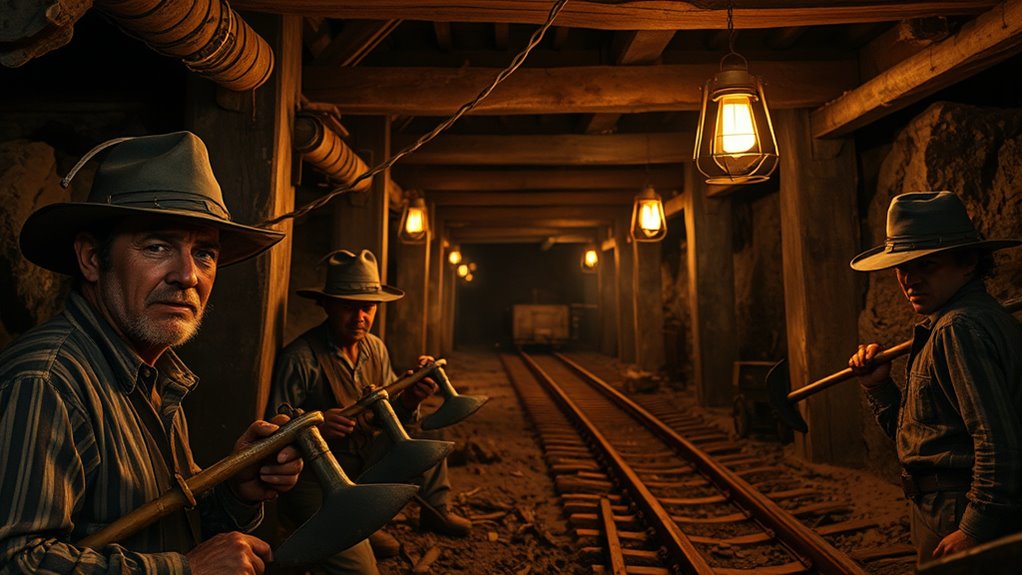Mining classic footage in the public domain lets you access vintage clips that are free to use in your fan projects without legal worries or licensing fees. You can incorporate these timeless scenes to create unique, engaging content without concern for copyright infringement. Properly identifying and restoring these clips can enhance your work markedly. If you keep exploring, you’ll discover tips on how to effectively find, restore, and legally incorporate public domain footage into your creative projects.
Key Takeaways
- Public domain footage provides free, legal content, ideal for creative fan projects without copyright concerns.
- Restoring vintage clips with digital tools enhances quality and visual appeal for modern audiences.
- Verify public domain status to ensure footage is free to use and avoid potential legal issues.
- Proper archiving and organization streamline access and preservation of classic footage for ongoing use.
- Be aware of licensing restrictions on accompanying media like music or narration to maintain project compliance.

If you’re looking to create compelling fan projects, public domain footage offers a valuable resource that can save you time and legal worries. These classic clips open up a world of creative possibilities without the fears of copyright infringement. However, to make the most of this footage, understanding restoration techniques and licensing considerations is essential. Restoring old footage often involves fixing damaged frames, removing dust or scratches, and enhancing image quality. Using digital tools like noise reduction software, color correction, and stabilization can bring vintage footage back to life, making it more appealing for modern audiences. Keep in mind, though, that some clips may require more extensive restoration, especially if they’re very old or poorly preserved. This process demands technical skill and patience but can considerably elevate the quality of your project, making the footage look fresh and engaging. Regularly assessing and rotating your footage can also help maintain a cohesive and organized project workflow. Additionally, exploring digital restoration techniques can significantly improve the final appearance of your clips and save you time in the editing process. Employing proper archiving methods ensures your restored footage remains accessible and protected for future use. When working with public domain footage, licensing considerations are equally important. Since these clips are legally free to use, you don’t need to worry about paying royalties or obtaining additional permissions. Still, it’s crucial to verify that the footage is genuinely in the public domain. Sometimes, what appears to be free may have restrictions if it was published with certain conditions or if rights were transferred later. Double-check the source and the public domain status to avoid legal issues. Additionally, even if the footage is in the public domain, you should consider the licensing of any accompanying elements like music, narration, or other media you plan to incorporate. Ensuring all components are appropriately licensed helps keep your project on the right side of the law. Incorporating space-saving techniques such as digital archiving can further streamline your project management and preservation efforts.
Frequently Asked Questions
Can Public Domain Footage Be Used Commercially Without Restrictions?
You might think you can use public domain footage commercially without restrictions, but it’s wise to contemplate copyright concerns and licensing requirements. While public domain works are free of copyright restrictions, verify that the footage is genuinely in the public domain and hasn’t been subject to new licensing terms. Always double-check the source to avoid legal issues, and remember that some uses might still have specific limitations or obligations.
How Can I Verify if Footage Is Truly in the Public Domain?
Think of verifying footage’s public domain status like steering through a maze. To find your way, you must check the copyright status and source verification carefully. Start by researching the original source, looking for clear public domain declarations or expiration dates. Consult official government databases, reputable archives, or copyright experts to guarantee the footage is truly free to use. This way, you avoid pitfalls and use content confidently.
Are There Any Quality Limitations When Using Old Public Domain Footage?
When using old public domain footage, you might face quality limitations due to restoration challenges. The footage could have visual artifacts like scratches, flickering, or fading, which can affect your project’s clarity. You’ll need to carefully clean and enhance the footage, possibly using editing software, to improve its quality. Be prepared for these restoration challenges, but with effort, you can considerably improve the visual appeal of vintage clips.
What Are the Legal Risks of Using Public Domain Footage?
When you use public domain footage, you might face legal risks like copyright concerns if the footage isn’t truly in the public domain or has licensing ambiguities. Always verify the source and guarantee it’s genuinely free of restrictions. If you overlook these details, you could unintentionally infringe on rights, leading to potential legal action. Being cautious and thorough helps protect you from these risks and keeps your project safe.
How Do I Properly Credit Public Domain Sources in My Project?
When you use public domain sources in your project, you need to follow proper attribution standards to give credit correctly. You should cite sources using appropriate citation formats, such as MLA or Chicago style, depending on your project’s requirements. Clearly mention the creator (if known), title, and source of the footage. This not only respects intellectual property but also maintains transparency and credibility in your work.
Conclusion
By exploring public domain footage, you open up endless creative possibilities for your fan projects. Imagine crafting a short film using vintage clips from the 1920s—bringing history to life or reimagining classic scenes with your own twist. For instance, a fan recreated a famous sci-fi scene using public domain footage, giving it a fresh, unique feel. So go ahead, plunge into the archives, and let your imagination run wild with what’s available.









